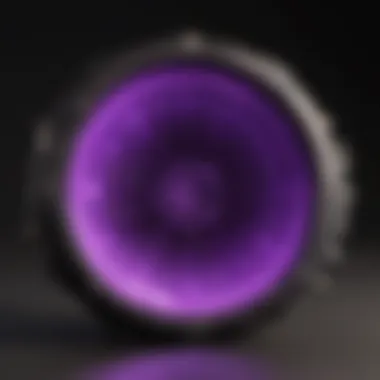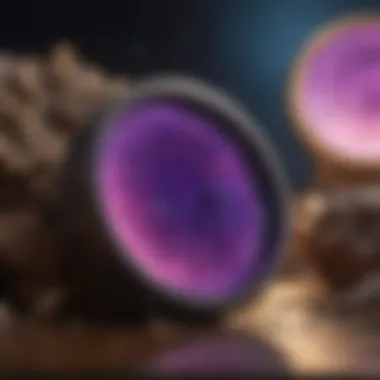Unlocking the World of Ultraviolet Light Sources Near You: A Comprehensive Guide


Rock and Fossil Identification
When delving into the realm of ultraviolet light sources available for sale nearby, it is crucial to first understand the different types and characteristics they possess. Various types of ultraviolet lights emit different wavelengths, each with its unique applications and effects. From black lights to UV LEDs, the selection available offers a range of options for different purposes. Buyers must consider the intensity and quality of light emitted by each type to ensure it aligns with their intended use.
Moving on to the identification process, individuals seeking ultraviolet light for sale near them should be aware of the key characteristics to look for. These include the output spectrum, power source, durability, and portability of the light source. Understanding these features is essential to make an informed decision and select a UV light that best suits one's needs.
Additionally, having the right tools for identifying and testing ultraviolet light sources is paramount. UV light meters, spectrometers, and fluorescent materials are valuable tools that aid in assessing the quality and performance of UV lights for sale. These tools provide insights into the intensity, wavelength accuracy, and consistency of the light emitted, enabling buyers to make a well-informed purchase decision.
Preservation and Display
Once a suitable ultraviolet light source is acquired, proper preservation and display techniques become paramount. Proper preservation methods ensure the longevity and functionality of the UV light, prolonging its lifespan and efficiency. Storing the UV light in a cool, dry place and protecting it from physical damage or excessive heat can significantly extend its operational life.
In terms of display, there are various creative ideas to showcase ultraviolet light sources effectively. Utilizing UV light stands, display cases with UV-filtering glass, or incorporating UV-responsive materials can enhance the presentation of UV lights. Consideration should also be given to the aesthetic appeal and visibility of the light source when selecting a display method, ensuring it enhances both the functionality and visual impact of the UV light.
Geological Insights
While delving into the world of ultraviolet lights for sale, it is insightful to explore the geological insights that can be gained through UV light applications. UV lights can aid in identifying fluorescent minerals, fossils, and geological formations by revealing unique characteristics under UV illumination. Understanding the geological significance of fluorescence can offer valuable insights into the composition and history of rocks, fossils, and minerals.
Furthermore, UV light can unveil hidden details and patterns in geological specimens that may not be visible under normal light. By studying the fluorescence properties of rocks and minerals, enthusiasts can gain a deeper understanding of geological formations, mineral structures, and historical processes that have shaped the Earth's surface. This knowledge enhances the appreciation and scientific understanding of the natural world, making the exploration of ultraviolet light sources a fascinating journey into the depths of geological insights.
Understanding Ultraviolet Light
What is Ultraviolet Light?
Ultraviolet (UV) light is a form of electromagnetic radiation with shorter wavelengths than visible light, making it invisible to the naked eye. The properties of UV light include higher energy levels compared to visible light, allowing it to interact uniquely with materials. Understanding the definition and properties of UV light is pivotal in highlighting its effectiveness in different applications and its potential implications for health and safety within this article.
Types of Ultraviolet Light
Ultraviolet light is categorized into three main types: UV-A, UV-B, and UV-C. Each type varies in wavelength and energy, leading to diverse applications and potential risks. Examining the distinctions among these classifications is essential to understand their relative strengths and limitations, aiding readers in selecting the most suitable UV light source for their specific needs within this article.


Applications of UV Light
UV light finds utilization in numerous fields, including medicine, industry, forensics, and domestic settings. The diverse applications range from sterilization and disinfection to material curing and fluorescent inspections. Exploring the diverse uses of UV light sheds light on its versatility and underscores its relevance in a multitude of industries, guiding individuals in choosing the appropriate UV light sources based on their intended applications.
Finding Ultraviolet Light Sources Near Me
In the quest for exploring ultraviolet light sources available for purchase, the aspect of finding these sources near you holds paramount significance. This section aims to provide insights into the convenient access to UV light products, emphasizing specific elements that facilitate the process. When seeking ultraviolet light sources in proximity, considerations such as accessibility, variety, and quality come to the forefront.
Local Stores Offering UV Light
Specialty Lighting Shops
Specialty Lighting Shops play a vital role in providing a niche selection of UV light products tailored to specific requirements. Their key characteristic lies in offering a diverse range of UV light fixtures, bulbs, and accessories that cater to various uses. The advantage of these shops is the specialized knowledge and focused inventory they possess, making them a popular choice for enthusiasts seeking reliable UV light solutions. The unique feature of Specialty Lighting Shops is their emphasis on providing expertise in UV lighting, ensuring customers receive products designed for optimal performance according to their needs.
Hardware Stores
Hardware Stores contribute to the accessibility of UV light products by offering a more general yet practical range of options. Their key characteristic includes a broader selection of UV-related tools and equipment alongside other hardware products, making them a convenient choice for a one-stop shopping experience. The benefit of Hardware Stores lies in their versatility and budget-friendly offerings, catering to a wider audience interested in exploring UV light applications. While Hardware Stores may lack the specialized focus of Specialty Lighting Shops, their advantage lies in providing a diverse array of products for varied needs.
Scientific Equipment Suppliers
Scientific Equipment Suppliers bring a sophisticated edge to the availability of UV light sources, emphasizing precision and technical specifications. Their key characteristic revolves around supplying advanced UV technology suited for scientific and professional applications. The benefit of sourcing UV light products from Scientific Equipment Suppliers is the assurance of high-quality, research-grade equipment for specialized uses. The unique feature of Scientific Equipment Suppliers lies in their commitment to cutting-edge innovations and providing tailored solutions, making them a preferred choice for those prioritizing technical specifications and performance.
Choosing the Right UV Light Source
Choosing the right UV light source is a critical aspect when venturing into the world of ultraviolet light sources available for purchase. Selecting the appropriate UV light source involves considering various factors to ensure the desired functionality and performance. Whether for medical, industrial, forensic, or domestic use, understanding the specific requirements is essential for making an informed choice that aligns with your needs. By evaluating key elements such as purpose of use, wavelength requirements, and power source/portability, you can pinpoint the ideal UV light source for your intended application.
Factors to Consider
- Purpose of Use:
- Wavelength Requirements:
- Power Source and Portability:
Purpose of Use:


- The purpose of use plays a pivotal role in determining the type of UV light source that best suits your requirements. Whether you need it for sterilization, fluorescent inspection, or curing applications, choosing a UV light source tailored to your specific purpose ensures optimal results. Different UV wavelengths cater to varying purposes, so identifying the exact use case enhances the effectiveness of the selected light source.
Wavelength Requirements:
- Wavelength requirements signify the specific range of UV light spectrum crucial for your intended application. UV-A, UV-B, and UV-C classifications offer distinct wavelengths suitable for various tasks. Understanding the wavelength requirements enables you to select a UV light source that emits the appropriate UV rays essential for accomplishing your desired goals.
Power Source and Portability:
- The power source and portability features are vital considerations in choosing a UV light source. Whether you opt for battery-powered handheld devices or plug-in units, assessing the convenience of power sources enhances the usability of the light source. Additionally, evaluating the portability aspects ensures ease of transportation and handling, particularly for on-the-go or fieldwork applications.
Quality and Brand Considerations
- Popular UV Light Brands:
- Customer Reviews and Recommendations:
Popular UV Light Brands:
- Recognizing popular UV light brands provides insights into reputable manufacturers known for their quality products. Established brands often offer a wide range of UV light sources with proven durability and efficiency, instilling confidence in the reliability of their products. Choosing from renowned brands ensures access to reliable UV light sources backed by industry expertise and innovation.
Customer Reviews and Recommendations:
- Customer reviews and recommendations offer valuable feedback from users who have firsthand experience with specific UV light sources. By exploring customer testimonials and recommendations, you gain valuable insights into the performance, reliability, and usability of different UV light models. Leveraging peer feedback assists in making informed decisions and narrowing down options based on real-world user experiences.
Safety Precautions with UV Light
Safety precautions when dealing with ultraviolet (UV) light are paramount in ensuring the well-being of individuals working with this type of lighting. In this article, we delve into the crucial aspects of maintaining safety when utilizing UV light sources. By understanding and implementing proper safety measures, users can minimize risks and maximize the benefits of UV light technology.
Protective Gear and Usage Tips
UV-Blocking Eyewear


UV-blocking eyewear plays a pivotal role in safeguarding the eyes from harmful UV rays. These specialized glasses are designed to filter out the potentially hazardous effects of UV light, protecting the delicate tissues of the eyes. The key characteristic of UV-blocking eyewear lies in its ability to block specific wavelengths of ultraviolet radiation while allowing safe light transmission. Choosing appropriate UV-blocking eyewear is essential for anyone working with UV light, as it prevents eye damage and promotes safe usage. Despite their undeniable benefits, some drawbacks include potential discomfort due to prolonged wear, highlighting the importance of selecting comfortable and high-quality eyewear for prolonged use.
Skin Protection Measures
Skin protection measures are vital when working with UV light to prevent any harmful effects on the skin. It is crucial to shield exposed skin areas from direct UV exposure to reduce the risk of skin damage and potential burns. Implementing skin protection measures such as wearing appropriate clothing and using sunscreen can offer effective defense against UV radiation. The key characteristic of skin protection measures is their ability to form a barrier between the skin and UV rays, thereby reducing the likelihood of adverse skin reactions. While these measures are beneficial for overall safety, individuals should be mindful of potential skin sensitivities to certain protective products and adjust their usage accordingly.
Avoiding Overexposure
In the realm of UV light usage, avoiding overexposure is a critical principle for maintaining safety and minimizing health risks. By understanding safe exposure limits and adhering to recommended guidelines, individuals can prevent the negative consequences of excessive UV light exposure and safeguard their health.
Time Limits for Safe Exposure
Setting time limits for safe exposure to UV light is essential in preventing overexposure and associated health concerns. By defining clear boundaries for UV light usage duration, individuals can protect themselves from the harmful effects of prolonged exposure. The key characteristic of time limits for safe exposure is their role in controlling UV light intake and preventing potential injuries. Adhering to specified time limits ensures that individuals optimize the benefits of UV light while minimizing risks. However, it is crucial to balance the benefits of UV exposure with safe time constraints to achieve a healthy equilibrium for enhanced well-being.
Maintaining and Caring for UV Light Sources
In the realm of ultraviolet light, proper maintenance and care of UV light sources are paramount to ensure their longevity and effectiveness. This section delves into the crucial aspects of maintaining and caring for UV light sources, shedding light on why such practices are essential for enthusiasts and professionals alike.
Cleaning and Storage Guidelines
Proper Cleaning Procedures
Proper Cleaning Procedures are indispensable when it comes to ensuring the optimal performance of UV light sources. By detailing specific steps and techniques for cleaning UV lights, users can maintain their equipment in top condition. The meticulous focus on keeping UV lights clean not only enhances their output but also prolongs their lifespan. This article emphasizes the significance of following the correct cleaning procedures to safeguard the quality and functionality of UV light sources.
Safe Storage Practices
Safe Storage Practices play a pivotal role in preserving the integrity of UV light sources when not in use. Proper storage techniques prevent damage and prolong the shelf life of UV lights, ensuring they remain in prime condition for future use. This section underlines the importance of storing UV light sources in a secure and appropriate manner to prevent degradation and maintain peak performance.
Routine Maintenance Tips
Checking Bulb Integrity
Checking Bulb Integrity is a critical component of maintaining UV light sources. Regular inspections of bulbs help identify any signs of wear, damage, or malfunction, allowing users to address issues promptly. By focusing on ensuring the integrity of bulbs, individuals can maximize the efficiency and longevity of their UV light equipment. This segment stresses the significance of routine checks to uphold the functionality and safety of UV light sources.
Testing Output Regularly
Testing Output Regularly is a proactive measure that ensures UV light sources are emitting the required intensity and wavelength. By regularly testing the output of UV lights, users can validate their performance and make adjustments as needed. This section articulates the importance of consistent output testing to guarantee the efficacy and reliability of UV light equipment, highlighting the benefits of this practice for maintaining optimal performance.







